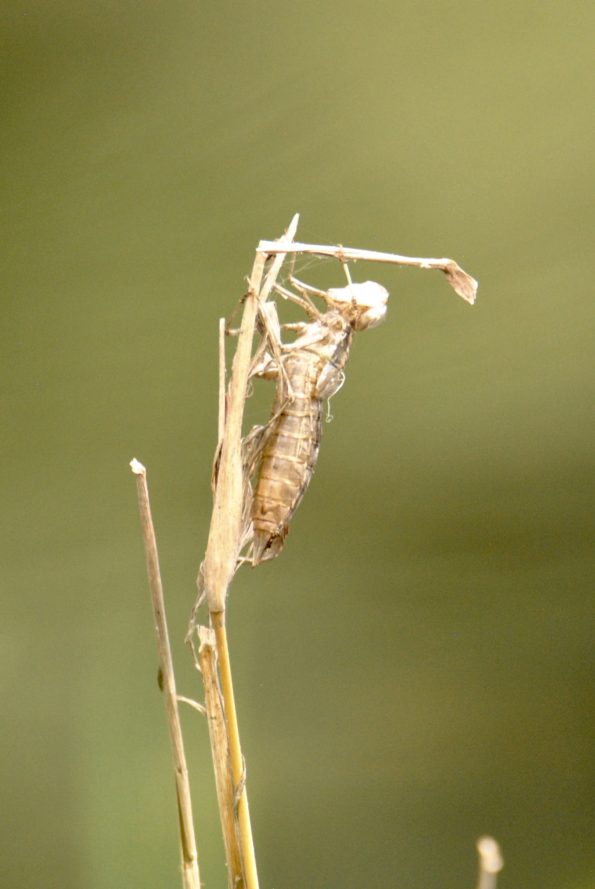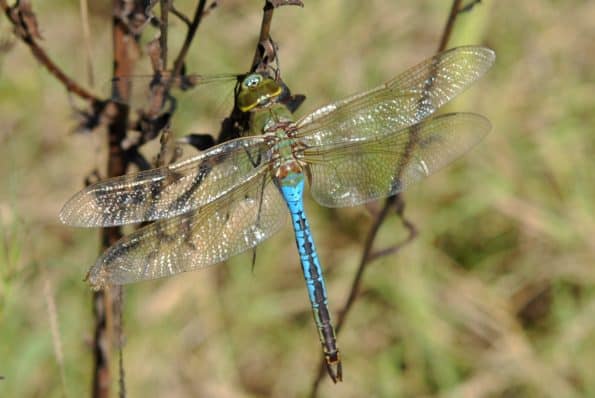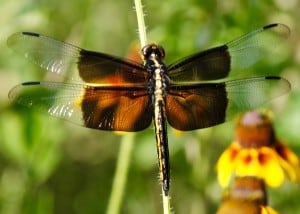Dragonflies rule the insect kingdom at Little Piney, at least in my mind. Like their namesake, the mythological dragon, they are both beautiful and fierce. Swift and deadly hunters, dragonflies fly forward at about 100 body-lengths per second, and backwards at about 3 body-lengths per second. This translates to up to 38 miles per hour for larger dragonflies! They can also hover like a helicoptor for as much as a minute. Large compound eyes see almost 360 degree, and 80% of the dragonfly brain is devoted to vision. It’s hard to hide from a dragonfly
Dragonflies may eat as much as a fifth of their own body weight in a day’s time. These hungry carnivores consume everything from mosquitoes to butterflies, and even smaller members of their own species.
The life-cycle of the dragonfly is as fairytale-like as it’s name. One to six years are spent underwater as larvae. The larvae surface again and again over the years to molt then return to pond life below. Finally, one spring day, a plain dark nymph, climbs up a blade of water grass and out of the pond forever. From this homely skin, a dazzling adult emerges and soars away on shimmering wings to begin its short but beautiful life. Rapunzel in a pond? Photographer Andy Holt has captured the amazing process in a video worth watching posted on Ark in Space, a nature blog.
I found a shed skin on a twig here at Dragonfly Pond–

Sometimes dragonflies are quick and camera shy; other times they pose to show off their sunlit colors. Below are the different types of dragonflies I have photographed so far. I hope to have a longer zoom lens soon so that I can replace some of these blurry photos with sharp ones. Click on each image for the name.


Most of my information came from wikipedia and Odonata Central.org. For identification Dragonflies and Damselflies of Texas on Flicker.
And http://www.insectidentification.org is great site for insect identification.







Wow Tammy, until your post, I’d never paid that much attention to Dragonflies. They are beautiful in their range of fluorescent colors,
and their lives are sort of fantastical…thank you for increasing my awareness, Dragonflies, you have captured my attention!
Thanks for your comment, Andrea. They are also good food for our larger birds!
[…] them happen. Sunday afternoon, Ken and I got to experience one of those moments when a very large dragonfly, a Common Green Darner, zipped by with a another insect in tow. Another dragonfly, identical to […]
[…] the dragonflies will lure me out into the fields with my camera. Two summers ago I wrote “Dragonflies and Fairytales” which covers a few basics about dragonflies and their fascinating life cycle. Recently I […]